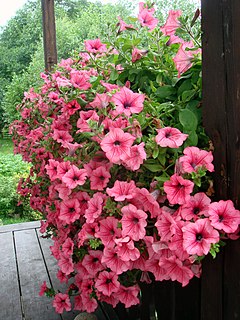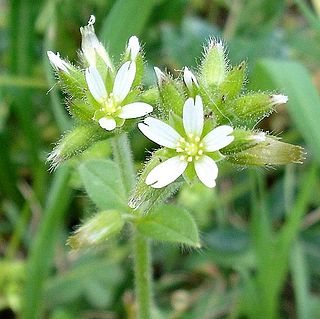
Cerastium glomeratum is a species of flowering plant in the pink family known by the common names sticky mouse-ear chickweed and clammy chickweed. It is probably native to Eurasia but it is known on most continents as an introduced species. It grows in many types of habitat. The blooming period is February, March, April, and May.

Spergularia rubra, the red sandspurry or red sand-spurrey, is a plant species in the pink family. It is native to Europe and Asia, and it is present on other continents, including North and South America and Australia, as an introduced species and in many areas a common weed. It grows in a wide variety of habitat types.
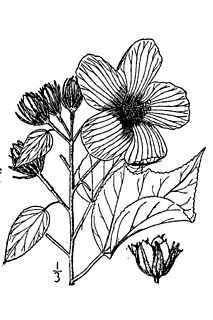
Hibiscus lasiocarpos is a species of hibiscus known by the common name hairy-fruited hibiscus. It is also one of several hibiscus called rosemallow. It is native to much of the southeastern United States, as well as parts of California and northern Mexico. It is a large, bushy perennial herb with sprawling stems reaching one to two meters long. The leaves are heart-shaped, toothed, and pointed, and generally between 6 and 10 centimeters long. The inflorescence holds large showy, solitary flowers. Each flower has a cup of partly fused sepals beneath a layer of slender bracts. These may be covered in hairs or woolly fibers. The flower's large petals may be up to 10 centimeters long and are generally bright white with red bases. The stamen tube and anthers are white or cream. The fruit is a capsule 2.5–3 centimeters long containing spherical seeds.

Boechera sparsiflora is a species of rockcress known by the common names sicklepod rockcress and elegant rockcress. It is native to western North America from California to Utah to Yukon, where it can be found in a number of habitats. This is a coarsely hairy perennial herb growing one or more thick stems from a caudex. The stem may branch or not and it reaches up to 90 centimeters in maximum height. The leaves vary in shape from linear to arrowhead-like and may or may not have toothed edges. They are usually hairy and up to 8 or 10 centimeters long. The raceme inflorescence bears a number of flowers with spoon-shaped petals about a centimeter long in shades of purple or pink. The fruit is a large, curved silique 6 to 12 centimeters long
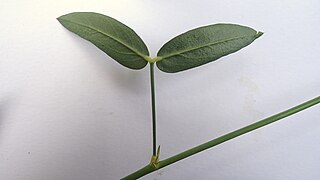
Zornia latifolia is a species of flowering plant in the legume family, Fabaceae. It is native to South America. Its distribution may extend into Central and North America. It is also known as a naturalized species in tropical western Africa. The plant is known commonly as maconha brava.

Angelica kingii is a species of angelica known as King's angelica. It is native to the western United States, especially the Great Basin region. This is a taprooted perennial herb varying in shape and size. It produces an erect, hollow stem to heights between 30 centimeters and two meters. The large leaves are composed of many lance-shaped leaflets each up to 12 centimeters in length. The inflorescence is a compound umbel with up to 14 long rays each holding clusters of small hairy flowers. The fruit is a pair of bodies about half a centimeter long each containing a seed.

Orobanche cooperi is a species of broomrape known by the common name Cooper's broomrape desert broomrape, spike broomrape, and burroweed strangler. It is native to the desert regions of the southwestern United States and northern Mexico, where it is a parasite growing attached to the roots of other plants, usually members of the Asteraceae, such as Artemisia, Hymenoclea, Ambrosia and Encelia. Although not usually weedy, it has been found infesting agricultural cropland, including tomato fields in inland California. This plant arises from a thick root and a scaly, twisted stem base, and produces a thick, clumpy stem up to 40 centimeters tall. As a parasite taking its nutrients from a host plant, it lacks leaves and chlorophyll. It is dark purple in color and coated with glandular hairs. The inflorescence is an elongated array of several flowers. Each flower is tubular, purple and hairy, and up to about 3 centimeters long.

Orobanche vallicola is a species of broomrape known by the common name hillside broomrape.
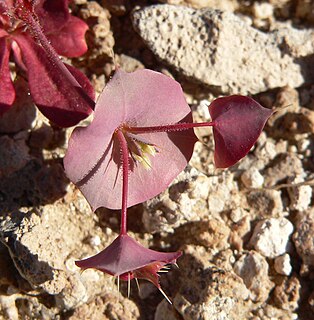
Oxytheca perfoliata is a species of flowering plant in the buckwheat family known by the common names round-leaf puncturebract and roundleaf oxytheca. It is native to the southwestern United States, where it is a common plant of the deserts and some woodland and valley areas. It is an annual herb producing a leafless stem up to about 20 centimeters in maximum height in the spring; during the winter the plant is a small rosette of oblong or spoon-shaped leaves a few centimeters wide. The plant is red-veined green, or often brown to maroon or magenta in color. The inflorescence atop the stem is punctuated by nodes at which the bracts are fused to form a cup or band up to about 2.5 centimeters wide. At the end of each branching of the stem is a similar cup of bracts partially fused around a cluster of flowers. The bracts are tipped in spinelike awns. The flowers are white to yellow-green and hairy in texture.
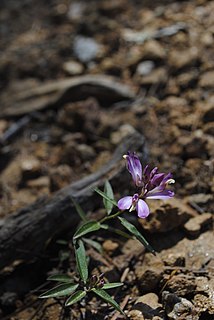
Polygala californica is a species of flowering plant in the milkwort family known by the common name California milkwort. It is native to southwestern Oregon and northern and central California, where it grows in the coastal mountain ranges in local habitat types such as chaparral and forest. It is a perennial herb producing spreading stems, generally decumbent in form, up to about 35 centimeters in maximum length, lined with narrow oval leaves each a few centimeter long. The upper inflorescences produce several open flowers, and there may be some closed, cleistogamous flowers lower on the plant. The open flowers have pink or white winglike lateral sepals with hairy edges. The petals are similar in color, the central one tipped with a white or yellow beak. The fruit is a flattened green capsule up to a centimeter long containing hairy seeds.

Senna multiglandulosa is a species of flowering plant in the legume family known by several common names, including glandular senna, downy senna, and buttercup bush. It is native to Mexico, Guatemala, and western parts of South America, but it is widely cultivated as an ornamental plant and in some areas of the world has become naturalized in the wild. In some places it is considered a weed, for example, in New Zealand and New South Wales.

Silene gallica is a species of flowering plant in the pink family known by several common names, including common catchfly, small-flowered catchfly, and windmill pink. It is native to Eurasia and North Africa, but it can be found throughout much of the temperate world as a common roadside weed. It is an annual herb growing up to 40 or 45 centimeters tall, its branching stem coated in long, curling hairs and shorter, glandular hairs. The lance-shaped leaves are up to 3.5 centimeters long low on the plant, and smaller on the upper parts. Flowers occur in a terminal inflorescence at the top of the stem, and some appear in the leaf axils. Each flower has a tubular calyx of fused sepals lined with ten green or purple-red veins. It is coated in long hairs. It is open at the tip, revealing five white, pink or bicolored petals, each with a small appendage at the base.

Sisymbrium orientale is a species of flowering plant in the mustard family known by the common names Indian hedgemustard and eastern rocket. It is native to Europe, Asia, and North Africa, and it can be found throughout much of the temperate world as an introduced species and in some areas a common roadside weed. It is an annual herb producing a hairy, branching stem up to about 30 centimeters tall. The basal leaves are divided into deep lobes or toothed leaflets. Leaves higher on the stem have lance-shaped blades with small separate lobes near the base. The top of the stem is occupied by a raceme of flowers with light yellow petals each measuring up to a centimeter long. The fruit is a silique which can be up to 10 centimeters long.

Solanum triflorum is a species of nightshade known by the common names cutleaf nightshade and small nightshade. It is native to Argentina, but it is known on other continents, including Europe and Australia, as an introduced species and sometimes a weed. It is present throughout much of North America, where it is possibly non-native as well. It grows in many types of habitat, including disturbed areas. It is an annual herb producing spreading, decumbent stems up one meter long. It is hairy, the hairs sometimes associated with glands. The leaves are a few centimeters long and are deeply cut into toothlike lobes. The inflorescence bears two or three flowers each just under a centimeter wide when fully open. The flower is usually white, but is occasionally purple-tinged. The fruit is a berry roughly a centimeter wide.

Stachys arvensis is a species of flowering plant in the mint family known by the common names field woundwort and staggerweed. It is native to Europe, Western Asia, and North Africa. It is known on other continents as an introduced species and widespread weed.
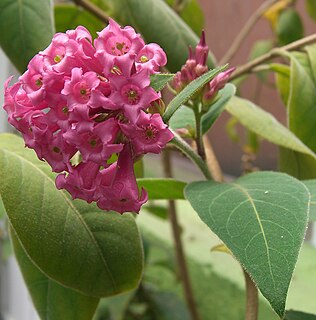
Cestrum elegans, the purple cestrum, also known as red cestrum, Cestrum purpureum, or Bastard Jasmine, is a species of flowering plants in the genus Cestrum.
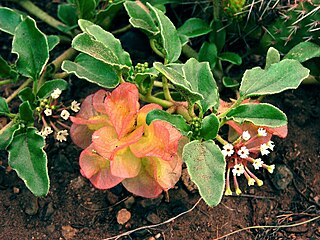
Tripterocalyx micranthus is a species of flowering plant in the four o'clock family known by the common names smallflower sandverbena and small-flowered sand-verbena.

Vicia benghalensis is a species of vetch known by the common names purple vetch and reddish tufted vetch. It is native to southern Europe, North Africa, and nearby islands, and it is utilized elsewhere in agriculture and may be present in the wild as an introduced species. It is an annual herb with a climbing stem which is coated in hairs, often densely, making the plant appear silvery white. Each leaf is made up of several pairs of elongated leaflets which measure up to 3 centimeters in length. The inflorescence is a one-side raceme of several dark reddish purple flowers. Each flower has a densely hairy calyx of sepals and a tubular corolla between one and two centimeters in length. The fruit is a flat, hairy legume pod up to 3.5 centimeters long containing multiple seeds.

Vicia pannonica is a species of vetch known by the common name Hungarian vetch. It is native to southern, central Europe and western Asia, and it is sometimes cultivated as an agricultural crop for use as hay and fodder. It may escape cultivation and grow as a casual roadside weed. This is an annual herb producing a hairy, climbing stem supported by the tendrils on its leaf-tips. The leaves are each made up of 10 to 20 oval or oblong leaflets measuring up to 2.5 centimeters in length. The inflorescence bears two to four pealike flowers each up to 2 centimeters long. The flower corolla is yellow or purple-marked and the back of the banner is coated in soft hairs. The fruit is a hairy legume pod 2 to 3 centimeters long.

Physaria tenella is a species of flowering plant in the mustard family known by the common names Moapa bladderpod and slender bladderpod. It is native to western North America from Utah to Sonora, where it grows mainly in desert habitat. This is an annual herb producing several hairy multibranched erect to spreading stems sometimes exceeding half a meter long. The basal leaves are up to 6.5 centimeters long and sometimes toothed, and there are smaller leaves higher on the stem. The inflorescence is a raceme of flowers at the tip of the stem. The mustardlike flower has four orange to bright yellow petals each up to a centimeter long. The fruit is a plump, hairy, rounded capsule.



